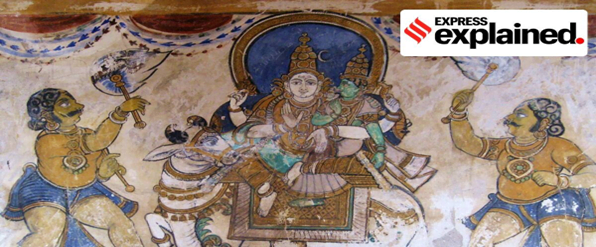History and Art and Culture
Context: A recently released film Ponniyin Selvan has focused on a fictional account of the 10th-century Chola dynasty. Cholas are known for their progressiveness, the architectural marvels and temples, the social setup of the time, and how cities were named after women.

The era of the Cholas:
Region of power:
- The Chola kingdom stretched across present-day Tamil Nadu, Kerala, and parts of Andhra Pradesh and Karnataka.
- It is one of the longest-ruling dynasties in world history.
Geographical extent:
- The heartland of the Cholas was the fertile valley of the Kaveri River.
- They unified peninsular India, south of the Tungabhadra, and held it as one state for three centuries.
- The Chola territories stretched from the Maldives in the south to the banks of the Godavari River in Andhra Pradesh as the northern limit.
Capital and important centres:
- Their early capital was at Thanjavur and later on at Gangaikonda Cholapuram.
- Kanchipuram and Madurai were considered to be regional capitals in which occasional courts were held.
Foundation of the dynasty:
- The dynasty was founded by king Vijaylaya, described as a “feudatory” of the Pallavas.
- Despite being a relatively minor player in the region among giants, Vijaylaya laid the foundation for a dynasty that would rule a major part of southern India.
- Under Rajaraja I and his successors Rajendra I, Rajadhiraja I, Rajendra II, Virarajendra, and Kulothunga Chola I, the dynasty became a military, economic and cultural powerhouse.
Contemporaries of Cholas:
- As one of the Three Crowned Kings of Tamilakam, along with the Chera and Pandya, the dynasty continued to govern over varying territories until the 13th century CE.
- During the period of the Cholas (around the 9th to 12th century AD), other powerful dynasties of the region would also come and go, such as
- The Rashtrakutas of the Deccan who defeated the Cholas, and
- The Chalukyas of the Andhra Pradesh region whom the Cholas frequently battled.
Society under the Cholas:
Agriculture & canals:
- There was tremendous agrarian expansion during the rule of the imperial Chola Dynasty all over Tamil Nadu and particularly in the Kaveri Basin.
- Most of the canals of the Kaveri River belong to this period.
Trade:
- While the extent of this domination is disputed, the Cholas had strong ties with merchant groups and this allowed them to undertake impressive naval expeditions.
A strong army and navy:
- One of the biggest achievements of the Chola dynasty was its naval power, allowing them to go as far as Malaysia and the Sumatra islands of Indonesia in their conquests.
- The domination was such that the Bay of Bengal was converted into a “Chola Lake” for some time.
- The dynasty became a military, economic and cultural powerhouse in South Asia and South-East Asia.
- Maintaining a strong army and naval resources made sense for the Cholas, because, the period from 9th to 10th century was a violent time, where kingdoms would go to war with each other frequently.
Art & Culture:

Example of the many frescos found in the pillared coloister that surrounds the courtyard of the Big Temple in Thanjavur, India.
Temple architecture:
- The Cholas built their temples in the traditional way of the Pallava dynasty, who were themselves influenced by the Amaravati school of architecture.
- The maturity and grandeur to which the Chola architecture had evolved found expression in the two magnificent temples of Thanjavur and Gangaikonda Cholapuram.
Brihadeeswara temple:
- The grand Brihadeeswara temple of Thanjavur, built by the Cholas, was the largest building in India in that period.
- This temple carries on its walls the engraved evidence of the elaborate administrative and financial procedures concerning the day-to-day administration of the temple.

Airavateswara temple:
- The Airavateswara temple at Darasuram near Thanjavur built during the reign of Rajaraja II is a magnificent structure typical of the stage of architectural development reached in the 12th century CE.
Sculptures:
- The Chola period is also remarkable for its sculptures and bronzes.
- Artworks and sculptures were commissioned by Chola kings and queens, including the famous bronze Nataraja idols.
- Chola period bronzes were created using the lost wax technique.
- Earlier, the Rashtrakutas had built the Kailasanatha temple in Maharashtra’s Aurangabad — the largest monolith structure (carved from a single rock) of its time.
Blots in the Chola history:
- The Chola rulers sacked and plundered Chalukyan cities including Kalyani and massacred the people, including Brahmans and children.
- They destroyed Anuradhapura, the ancient capital of the rulers of Sri Lanka.
Source: Indian Express
Previous Year Questions
Q.1) Consider the following pairs:
King Dynasty
- Nannuka Chandela
- Jayashakti Paramara
- Nagabhata II Gurjara-Pratihara
- Bhoja Rashtrakuta
How many pairs given above are correctly matched? (2022)
- Only one pair
- Only two pairs
- Only three pairs
- All four pairs
Q.2) Regarding the taxation system of Krishna Deva, the ruler of Vijayanagar, consider the following statements :
- The tax rate on land was fixed depending on the quality of the land.
- Private owners of workshops paid an industry tax.
Which of the statements given above is/are correct? (2016)
- 1 only
- 2 only
- Both 1 and 2
- Neither 1 nor 2














